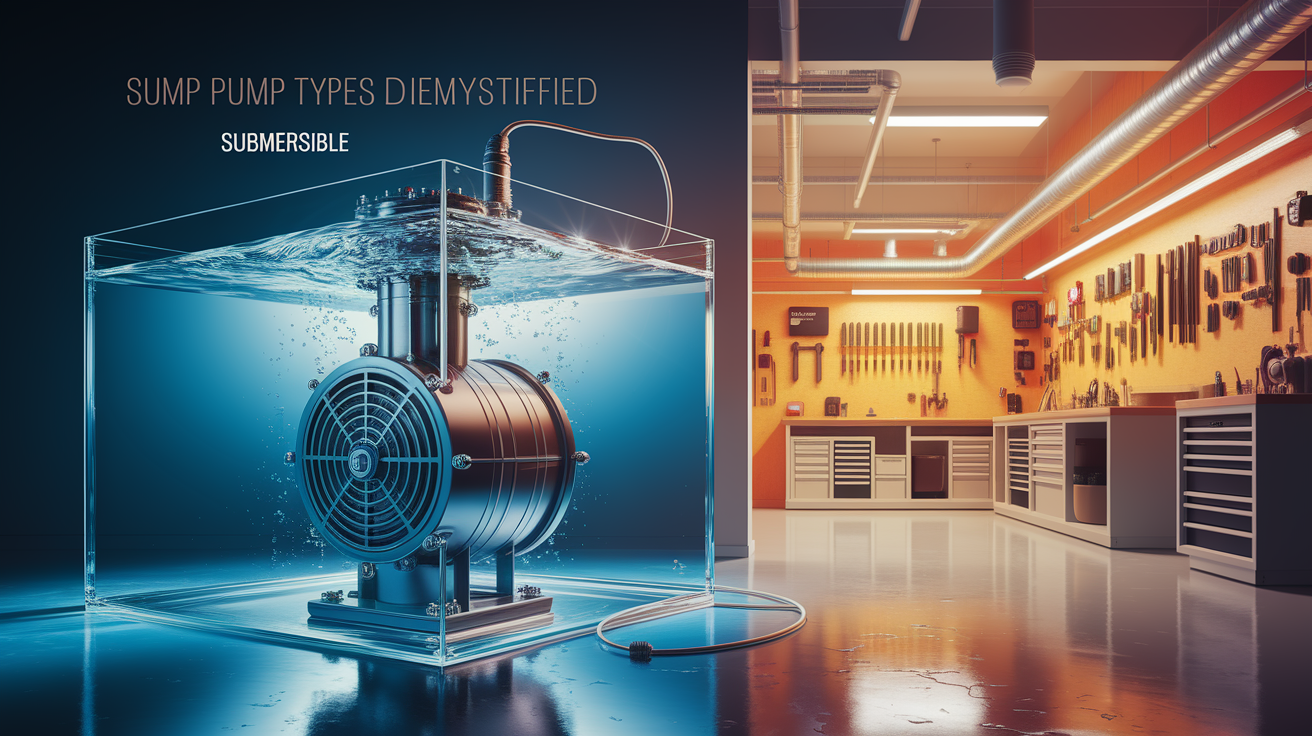Dry Foundations Begin Here
Your basement represents one of your home’s most vulnerable areas when it comes to water damage. With basement flooding becoming increasingly common across North America due to changing weather patterns and more frequent severe precipitation events, protecting this space has never been more critical. According to the Insurance Information Institute, water damage and freezing account for approximately 23.8% of all homeowners insurance claims, with an average claim cost of $11,098.

The statistics paint a sobering picture: the American Society of Home Inspectors estimates that nearly 60% of U.S. homes suffer from below-ground wetness or water damage. Climate change projections suggest these issues will only intensify, with many regions experiencing more concentrated rainfall events that overwhelm drainage systems.
Here’s the good news: a properly selected and installed sump pump system can be your first line of defense against basement flooding. According to the Basement Health Association, properly functioning sump pump systems can prevent up to 98% of basement water intrusion cases when correctly sized and installed. The key lies in understanding your specific needs and choosing the right system for your situation.
Know Your Basement’s Battlefield
Before diving into sump pump selection, you need to understand what you’re up against. Basement water issues stem from several common sources, each requiring different considerations for your flood prevention strategy:

Common Water Intrusion Sources
- Hydrostatic pressure: Groundwater pushing against foundation walls and floors
- Surface water drainage issues: Improper grading, clogged gutters, or downspouts directing water toward the foundation
- Rising water tables: Seasonal or climate-related changes in groundwater levels
- Storm sewer backup: Municipal systems becoming overwhelmed during heavy rainfall
- Foundation cracks: Allowing direct water penetration through concrete walls or floors
According to the American Society of Civil Engineers, approximately 14% of U.S. homes have foundation problems related to water issues, with repair costs averaging between $4,000 and $10,000. Understanding your specific water table conditions and drainage challenges will help you determine the right pump capacity and backup systems needed.
The Cost of Inaction
Water damage consequences extend far beyond immediate cleanup costs. Consider these potential impacts:
- Mold growth: Begins within 24-48 hours of water exposure
- Structural damage: Weakening of foundation walls and support structures
- Decreased property value: Homes with water issues typically sell for 15-20% less
- Increased insurance premiums: Or potential coverage denial for repeated claims
- Health issues: Respiratory problems from mold and mildew exposure
The Federal Emergency Management Agency (FEMA) estimates that just one inch of water can cause $25,000 in damage to a home, highlighting the importance of preventative measures like proper sump pump systems.
Sump Pump Types Demystified
Understanding the different types of sump pumps available will help you make an informed decision for your basement waterproofing needs. Each type offers distinct advantages depending on your specific situation and budget.

Primary Pump Options
Submersible pumps are designed to operate completely underwater within the sump pit. These units typically range from 1/3 to 1 horsepower and can move between 2,000-4,000 gallons per hour. They’re generally quieter but more expensive than pedestal models, with prices ranging from $100-$400. The submersible design makes them ideal for finished basements where noise reduction is important.
Pedestal pumps feature the motor mounted above the sump pit on a pedestal, with only the pump’s intake pipe submerged. These typically cost $60-$200 and last 25-30 years (versus 5-15 years for submersible models), but operate more loudly. Their accessibility makes maintenance easier, and they’re often the preferred choice for utility areas where noise isn’t a primary concern.
Essential Backup Systems
Power outages during storms can leave your primary pump useless when you need it most. Here’s how different backup systems work:
Battery backup pumps serve as secondary systems that activate during power outages or primary pump failure. Most can run for 7-10 hours continuously on a fully charged battery, providing crucial protection during extended outages. These systems typically include automatic operation with float switch activation.
Water-powered backup pumps use municipal water pressure to create suction that removes water. These require no electricity but typically move less water (1,000-1,500 gallons per hour) and increase water bills when operating. They work similar to how pressure booster pumps work, using water flow to create pumping action.
Generator-connected systems allow standard pumps to operate during power outages when connected to a home generator system. This option provides the most pumping capacity during emergencies but requires generator maintenance and fuel availability.
Modern Smart Pump Technology
The global sump pump market was valued at approximately $1.2 billion in 2021 and is projected to reach $1.8 billion by 2027, according to industry reports. Key technological advancements include:
- Smart sump pumps: Wi-Fi-enabled systems that send alerts to smartphones when issues arise
- Energy efficiency improvements: Modern pumps use 30-50% less electricity than models from 10 years ago
- Integrated backup systems: Primary pumps with built-in secondary pumping mechanisms
- Improved materials: Corrosion-resistant components extending operational life
- Variable speed motors: Adjust pumping rate based on water inflow volume
Power, Pressure, and Performance
Selecting the right pump capacity requires understanding your basement’s specific drainage needs and the relationship between pump horsepower, head pressure, and gallons per hour capacity.

Sizing Your Pump Correctly
Pump capacity depends on several factors that work together to determine water removal efficiency:
- Gallons per hour (GPH) rating at your specific head pressure
- Vertical lift requirements from sump basin to discharge point
- Horizontal run distance through the discharge pipe
- Expected water inflow volume during heavy rainfall
A 1/3 horsepower pump typically handles most residential applications, moving 2,000-3,000 gallons per hour at moderate head pressures. For deeper basements or higher discharge points, 1/2 or 3/4 horsepower units provide better performance under increased head pressure conditions.
Float Switch Options
The float switch controls automatic operation, and choosing the right type affects pump reliability:
- Tethered float switch: Most common and cost-effective option
- Vertical float switch: Requires less space and works well in narrow sump basins
- Electronic float switch: No moving parts, reducing maintenance needs
Quality Standards and Certifications
Look for pumps meeting these industry standards:
- UL 778: The Underwriters Laboratories standard for motor-operated water pumps
- CSA C22.2: Canadian Standards Association certification for electrical equipment
- SSPMA certification: Sump and Sewage Pump Manufacturers Association quality certification
Local building codes often dictate specific requirements for sump pump installations, particularly in new construction. The International Residential Code (IRC) includes provisions for foundation drainage systems in Section R405, which many local jurisdictions adopt or modify.
Installing and Caring for Your Pump
Proper installation and regular maintenance ensure your sump pump system provides reliable flood prevention when you need it most. While some homeowners tackle DIY sump pump installation, understanding the process helps you make informed decisions about professional versus self-installation.
Installation Essentials
A typical sump pump system consists of several key components working together:
- Sump pit/basin: A hole, typically 18-24 inches deep and 24 inches in diameter, dug at the lowest point of the basement
- Pump unit: The mechanical device that moves water
- Discharge pipe: Carries water away from the home’s foundation
- Check valve: Prevents backflow of water into the pit
- Power source: Typically electrical, though battery backups are common
The sump basin installation requires careful attention to proper grading and drainage capacity. Consider incorporating weep holes in the basin liner to allow groundwater entry while preventing soil infiltration.
Maintenance Schedule for Homeowners
Regular pump maintenance extends pump lifespan and ensures reliable operation:
Monthly Tasks
- Test pump operation by pouring water into the sump basin
- Check that the float switch moves freely
- Inspect discharge pipe for blockages or damage
Seasonal Tasks
- Clean debris from sump basin
- Test battery backup systems
- Verify discharge pipe extends appropriate distance from foundation
- Check for other plumbing issues that can affect your basement
Annual Tasks
- Professional inspection of electrical connections
- Replace battery backup batteries as needed
- Inspect pump impeller for wear or damage
Integration with Other Systems
Your sump pump works as part of your home’s overall water management system. Consider how it integrates with other components like French drains, basement waterproofing membranes, and foundation drainage systems. Issues like preventing overflow from laundry standpipes can complement your comprehensive basement protection strategy.
Pitfalls to Avoid
Even the best sump pump can fail to protect your basement if common installation and maintenance mistakes occur. Here are the most critical issues to avoid:
Common Installation Mistakes
- Inadequate pump sizing: Undersized pumps can’t handle heavy water inflow
- Improper discharge routing: Water must discharge away from the foundation, not toward it
- Missing check valve: Allows water to flow back into the pit after pumping
- Poor electrical connections: Can cause pump failure during critical moments
- Inadequate backup power: Primary pumps are useless during power outages
Maintenance Oversights
Neglecting regular maintenance leads to pump failure when you need protection most. Signs your sump pump needs replacement include:
- Irregular cycling or continuous operation
- Unusual noises during operation
- Rust, corrosion, or visible damage
- Age exceeding manufacturer recommendations
- Frequent power outage protection failures
System Design Flaws
Troubleshooting common sump pump problems often reveals system design issues rather than equipment failure. Ensure your system addresses:
- Adequate drainage capacity for your climate
- Proper integration with existing drainage systems
- Moisture detection and alarm systems for early warning
- Emergency backup protocols for extended outages
Seal the Deal on Dry Basements
Choosing the right sump pump for your basement protection needs requires balancing pump capacity, backup systems, and long-term reliability considerations. The investment in a quality sump pump system pays dividends through prevented water damage, maintained property values, and peace of mind during severe weather events.
Key Decision Factors
When making your final selection, prioritize these factors:
- Pump capacity matched to your basement’s drainage requirements
- Backup power options appropriate for your area’s power reliability
- Quality certifications ensuring long-term reliability
- Maintenance accessibility for ongoing care requirements
- Integration capabilities with smart home systems if desired
Remember that your sump pump system works best as part of a comprehensive approach to basement waterproofing. This includes proper grading, gutter maintenance, foundation sealing, and addressing issues throughout your home’s water management system. Ensuring your entire drainage system is functioning properly contributes to overall basement protection.
Professional vs. DIY Installation
While many homeowners successfully install sump pumps themselves, consider professional installation if your situation involves:
- Complex electrical work or code compliance requirements
- Integration with existing French drain systems
- Multiple backup system installations
- Structural modifications to basement floors
The cost of professional sump pump installation typically ranges from $500 to $1,500, depending on system complexity and local labor rates.
By understanding your basement’s specific water challenges, selecting appropriate pump and backup systems, and maintaining your equipment properly, you’ll have the foundation for effective flood prevention. A well-chosen sump pump system provides reliable protection against water damage while preserving your home’s value and your family’s safety.








